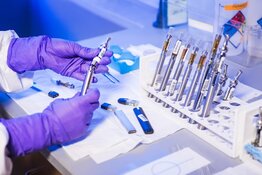The Life Sciences Report: You have followed a lot of different companies in your career as an analyst. Your current emphasis appears to be on immunotherapeutic and prophylactic agents, and on cellular therapies. Does that summarize your current focus?
Dennis Hulme: That covers the bulk of my coverage, yes. But there also are a number of standard, small-molecule therapies, particularly oncology drugs, in my coverage, as well as medical devices.
TLSR: Australia has been forward-thinking in the cellular therapy area. For instance, Mesoblast Ltd. (MESO:NASDAQ; MSB:ASE; MBLTY:OTCPK), even with its current market valuation more than cut in half from its highs, is still the largest cap pure-play cell therapy company on the planet. Why has Australia been more accommodating to the cell therapy industry?
DH: I think it's a combination of things. One is serendipity, with Mesoblast CEO Silvio Itescu being an Australian who was working in New York when he and his colleagues came up with the initial basis behind Mesoblast. But there certainly are advantages in Australia. In particular, a lot of the early preclinical work done by Mesoblast was performed in large animals such as sheep, and Australia is a particularly good place to do work of that nature.
"There is strong potential Regeneus Ltd. will strike a commercialization deal in Japan sometime this year; that's going to be the key driver."
There are two other advantages. The first is the clinical trials notification scheme, which allows first-in-human studies to be initiated in Australia with a lighter regulatory load than in a number of other countries. That makes it easier to get novel products tested in humans for the first time. The other advantage is that autologous cellular therapies [therapies using cells derived from and then returned to the same patient] have been considered exempt medical procedures that don't require separate regulatory approval, and that allowed a number of autologous technology companies to start up. Some of those have progressed on to allogeneic therapies [therapies using cells derived from the same species].
TLSR: Does that more permissive regulatory environment translate to cells that have been engineered, whether allogeneic or autologous?
DH: No. The permissive regulatory environment for use in human patients is restricted to autologous therapies, cells that haven't been substantially modified. My understanding is that now a number of companies doing allogeneic trials are going in through a simpler regulatory procedure as well.
TLSR: Excluding hematopoietic stem cell transplants, we are two decades into development of cell therapies. Why do you think cell therapy platforms have taken so long to get into pivotal stages?
DH: Part of it is the notion that these treatments are novel, and it follows that they are not particularly well understood. It's taken time to get a good understanding of the mechanism of action, learning about the cellular secretions—for example, cytokines—that are responsible for the majority of the effects you see. It's taken some time to identify the most appropriate indications.
"The clinical trials notification scheme allows first-in-human studies to be initiated in Australia with a lighter regulatory load."
Another thing is that the primary outcome measure, or endpoint, in most of these studies has been safety. Thus far, trials have been mostly exploratory for efficacy. A number of the diseases being addressed by proposed cell therapies are chronic, and many are degenerative in nature. It's taken some time to identify the most appropriate clinical endpoints to be measured in these clinical trials, and to accommodate a certain amount of trial and error to identify the best route for getting these therapies to market.
TLSR: You're a former wet lab bench investigator. You've worked in industry and in academia. You've also been an analyst for some time, working in the stock brokerage/investment bank industry. Where do you think the most potential for investors is over the next 5 to 10 years, as you look at these new, emerging technology platforms?
DH: I certainly think cellular therapies have a lot of potential, and there's a lot of groundwork being done now. Some of these product candidates are now into pivotal trials. Mesoblast is a good example. We're looking for the interim analysis from its heart failure trial around the middle of this year. That will be critical to validating the field.
I've been looking closely at an Australian company, Regeneus Ltd. (RGS:ASX). It is at an earlier stage of development than Mesoblast, but it has a human clinical trial underway in osteoarthritis with its product Progenza (allogeneic adipose-derived mesenchymal stem cells). Regeneus is pushing Progenza into early development in Japan, where it could potentially get a more rapid approval and a quicker return to investors.
"We've seen some dramatic improvements in patient outcomes with checkpoint inhibitors, so I think immuno-oncology going to be a continued area of focus."
Another area is immuno-oncology. We've seen some dramatic improvements in patient outcomes with checkpoint inhibitors, so I think that's going to be a continued area of focus. An Australian company, Prima BioMed Ltd. (PBMD:NASDAQ; PRR:ASX), is doing a lot of work with LAG-3 (lymphocyte activation gene-3) checkpoint inhibitors.
Another company looking to make use of the power of the checkpoint inhibitor is Viralytics Ltd. (VLA:ASX), which is headquartered right here in Sydney. It has oncolytic viral therapy called Cavatak (coxsackievirus A21, CVA21), which has shown very good efficacy in mid-stage trials in melanoma, and some promising results in bladder cancer.
Oncolytic viruses seem to be an ideal combination with checkpoint inhibitors. The virus can initiate an immune response, and checkpoint inhibitors effectively take the handbrake off to make the immune response more powerful. I think an oncolytic virus could be very effective in combination with a checkpoint inhibitor.
TLSR: You mentioned that you also follow medical devices. Do you have one such company you might briefly address?
DH: Sure. First I would say we're seeing increased interest in medical devices from investors here in Australia. Medical devices typically have lower development risks than therapeutic drugs and cellular therapies, so it's quicker to get them to market. There are challenges in growing market share with medical devices, but I've been looking at a very interesting company, Adherium Ltd. (ADR:ASX). It has developed smart asthma inhalers that provide reminders and feedback. Independent clinical studies have shown that these reminders produce dramatic improvements in patient compliance and adherence to maintenance asthma medications, and that leads to improvements in healthcare outcomes. Adherium has done a commercialization deal with AstraZeneca Plc (AZN:NYSE), which is starting to roll out Adherium's Smartinhaler devices in combination with its own dry powder inhaler in selected countries in Europe. With medical devices, getting to the market is quicker, with easier regulatory hurdles to clear and the potential to do deals with partners that can help you commercialize a product.
TLSR: You mentioned Regeneus. Let's talk about that for a moment. There is so much going on in this company—both in human and animal health. What does your growth theory hinge on for Regeneus?
DH: The key potential driver here is the off-the-shelf stem cell product it has gotten into clinical trials relatively quickly. Regeneus is in the middle of a Phase 1 trial with Progenza in patients with osteoarthritis of the knee. We have already seen good safety data from the first cohort of subjects. We expect to see data from the second cohort around the middle of the year.
"Cell therapy treatments are novel, and it follows that they are not particularly well understood."
More importantly for Regeneus, it is in advanced discussions with potential manufacturing and commercialization partners in Japan. It has the advantage due to the changed, improved regenerative medicine environment in Japan. You will recall that the Japanese Diet (legislature) approved legislation back in November 2013 that gave fast-track status to stem cell and regenerative medicine companies. I'm attributing 60% of my valuation of Regeneus to Progenza. There is strong potential that a commercialization deal will be struck in Japan sometime this year, and I think that's going to be the key driver for the company.
TLSR: Regeneus has had a very strong three-month period of share price appreciation—up almost 80% in Australian dollars. It's even up from one year ago, which makes it a rarity in small-cap life sciences companies. Progenza is in a 20-patient Phase 1 trial called STEP (safety, tolerability and efficacy of Progenza) in Japan, and the company's cancer vaccine, RGSH4K, would address a huge market of many billions of dollars. What about the focus on animal health? Has that been helpful to Regeneus? Do you think the company should divest its animal health program and focus on human health?
DH: The focus on animal health has been very helpful for Regeneus, particularly in the development of its manufacturing technology. If the company hadn't been doing the animal studies initially, it would not have been able to make such rapid progress in developing its human products.
The company's CryoShot Canine product for osteoarthritis has been selling to veterinary surgeons in Australia as part of an expanded clinical trial, and Regeneus is able to generate quite good margins on relatively modest volumes. Arthritis is a big problem for dogs, just as it is in humans. There are quite sizable commercial opportunities for these veterinary products.
Regeneus currently has a development partnership with a Top 5 veterinary company, which is jointly funding an ongoing pre-pivotal study of CryoShot Canine, and that allows Regeneus to reduce its development expenditure. The animal health program is an important area for Regeneus, both as a source of income and as a great way for the company to hone its technology.
TLSR: The human and animal health programs are both in osteoarthritis and in oncology. Does the intellectual property (IP) overlap in these programs?
DH: I think the IP is distinct enough that if Regeneus chose to, it could quite readily divest the animal health business. The area where there is overlap is in the manufacturing know-how. That's where it would be a little more difficult. But as far as divestment or licensing the applications of that know-how, that would be quite feasible.
TLSR: A U.S. ticker could give the company more visibility. Is Regeneus thinking about getting a NASDAQ or over-the-counter ticker?
DH: Australian companies have had mixed experiences with NASDAQ listings. Some companies have found it's quite beneficial, but a number feel they haven't gotten a lot of benefit from it. My experience, when I talk to U.S. investors, is that they like to invest in the markets with the greatest liquidity. For most of these companies, that's going to be on the Australian stock exchange (ASX). But, obviously, I'm talking to U.S. investors who are comfortable investing in Australia, and that may be a relatively small subset.
"With medical devices, getting to the market is quicker, with easier regulatory hurdles to clear."
There may be some advantage in a NASDAQ listing, but I'm just not convinced it's necessary for Regeneus. It still has the potential to attract U.S. investment with its current ASX listing.
TLSR: Regeneus was recently trading at a market cap of about AU$34 million (AU$34M). If it were trading in U.S. dollars, it might be around $27M. The market cap looks a little more enticing in Australian dollars. But can you get institutional investors into a stock with this kind of tiny market cap?
DH: It's always difficult with the very small- or micro-cap companies in early-stage development. At some stage you can do it. Certainly Mesoblast, which is trading under AU$800M, at around US$500M, is proof of that. I have faith that the technology at Regeneus can be sufficient for partners to make an investment in the company. If it is able to do a partnering deal, that would likely be a rerating catalyst for this stock's valuation, and may well attract some institutional investors.
TLSR: Thank you very much, Dennis.
Dennis Hulme joined Edison's healthcare team in November 2014 after almost 10 years covering the healthcare and agriculture sectors as an analyst at BBY Stockbrokers. Previously, he worked as a research scientist with CSIRO and the University of Sydney. Dr. Hulme has a Ph.D. in veterinary science from the University of Sydney.
Want to read more Life Sciences Report interviews like this? Sign up for our free e-newsletter, and you'll learn when new articles have been published. To see recent interviews with industry analysts and commentators, visit our Streetwise Interviews page.
DISCLOSURE:
1) Dr. George S. Mack conducted this interview for Streetwise Reports LLC, publisher of The Gold Report, The Energy Report and The Life Sciences Report, and provides services to Streetwise Reports as an independent contractor. He owns, or his family owns, shares of the following companies mentioned in this interview: None.
2) The following companies mentioned in the interview are sponsors of Streetwise Reports: Regeneus Ltd. Mesoblast Ltd. is not affiliated with Streetwise Reports. The companies mentioned in this interview were not involved in any aspect of the interview preparation or post-interview editing so the expert could speak independently about the sector. Streetwise Reports does not accept stock in exchange for its services. The information provided above is for informational purposes only and is not a recommendation to buy or sell any security.
3) Dr. Dennis Hulme: I own, or my family owns, shares of the following companies mentioned in this interview: None. I personally am, or my family is, paid by the following companies mentioned in this interview: None. My company has a financial relationship with the following companies mentioned in this interview: Regeneus Ltd., Mesoblast Ltd., Prima BioMed Ltd., Viralytics Ltd. and Adherium Ltd. I was not paid by Streetwise Reports for participating in this interview. Comments and opinions expressed are my own comments and opinions. I determined and had final say over which companies would be included in the interview based on my research, understanding of the sector and interview theme. I had the opportunity to review the interview for accuracy as of the date of the interview and am responsible for the content of the interview.
4) Interviews are edited for clarity. Streetwise Reports does not make editorial comments or change experts' statements without their consent.
5) The interview does not constitute investment advice. Each reader is encouraged to consult with his or her individual financial professional and any action a reader takes as a result of information presented here is his or her own responsibility. By opening this page, each reader accepts and agrees to Streetwise Reports' terms of use and full legal disclaimer.
6) From time to time, Streetwise Reports LLC and its directors, officers, employees or members of their families, as well as persons interviewed for articles and interviews on the site, may have a long or short position in securities mentioned. Directors, officers, employees or members of their families are prohibited from making purchases and/or sales of those securities in the open market or otherwise during the up-to-four-week interval from the time of the interview until after it publishes.













































